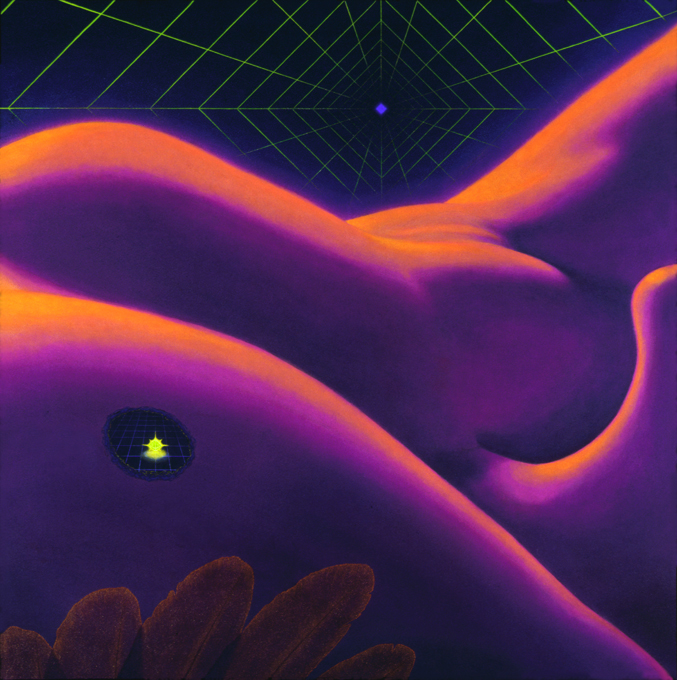

This painting is created from a cropped section (the upper part of the reclining woman) of Eye of Night. It began with a dream: I am with a group of people in a large building. We are on the top floor looking out into an atrium that reaches from the ground floor to the roof. We are to be shown a sacred object. The object is suspended before us in the atrium. It is like a large ornament that would be hung on a Christmas tree. It seems to be the figure of a young boy in ceremonial dress; it is golden and jewel encrusted. A man describes the object and then says the viewing is over. I see other features on the back of the ornament and ask the man why he hasn't talked about them. He denies they are there. I take the object and show the others what I see. One thing is the head of a king wearing a crown and the other is a dove. Including the boy this makes three features but for me there is a fourth thing and that is their matrix, the space they are suspended in. The matrix is the numinous thing; it is a great height or a great depth depending on your perspective and also the quality of the light.
Jung tells us that approximately every 2,000 years our god-image seems to undergo a transformation. The birth of Christ was such an event. Now, 2,000 years have passed and again god must evolve. Psychologically, god must evolve because the god-image represents our religious values and our value system that have become outworn and no longer suited for dealing with modern life. What are these outworn aspects of our god-image? The god-image as embodied by Christ is one of love and goodness. Christ is a god of light and does not contain the dark, earthy, feminine, instinctual, animal side of life. The body is considered sinful and we are told that Eve is in league with the devil. The Christian spirit separated mankind from nature. We have lost touch with the earth. But the light qualities of Christ were necessary to counter the barbarity of the Roman world and to save us from a brutal instinctuality. But then over time we have become too far removed from our instinctuality, so far removed that spirit and instinct, or matter, have become completely split apart into two worlds when they are really, at bottom, one world. People are both spirit and matter. Matter is not separate from the sacred. We contain both the dark and the light and so must our god-image.
The dream of the matrix seems to be talking about this transformation of the god-image. I'm shown a symbol of Christianity but the unconscious insists on adding something to that image and considers that something to be the most sacred thing. It is a fourth thing, and the fourth thing, according to Jung, is the dark feminine—the unconscious, the world of instinct, matter, the Grail, the dark aspect of Sophia, etc. The dream shows a spirituality that isn't working anymore because the dark aspect of the feminine is missing. The dark feminine is the matrix and the crowd does not consider it part of the sacred object, but the dream asks me to show that it is. So how do we let this dark spirit into our lives?
Jung writes about the idea that psyche (spirit) and matter are probably two aspects of the same reality; he refers to this unity that underlies the duality of existence as the unus mundus, the one world. Sophia symbolizes this unity. According to this hypothesis, it is the unitary nature of reality that allows for what Jung called synchronistic phenomena. In Number and Time, von Franz says a synchronicity "...consists of a symbolic image constellated in the inner psychic world, a dream, for instance, or a waking vision, or a sudden hunch originating in the unconscious, which coincides in a 'miraculous' manner, not causally or rationally explicable, with an outer event of similar meaning in the outer world." In the synchronistic moment, matter, the visible world, is taken symbolically. The synchronistic event becomes the religious moment because it allows the dark feminine, the light of nature, to speak directly to us.
In my imagination, the meteorite/jewel/Grail of the previous painting has landed in the heart of the figure. I think this painting portrays the experience of a synchronistic event. The jewel (our potential wholeness through the dark feminine) seems to represent an experience of the synchronistic moment and it is being perceived in the heart of the figure (see detail). We feel the synchronistic moment in the heart. It is an emotional experience; it makes your hair stand on end. You feel the oneness of existence, its Sophia reality. When you are open to the oneness of existence new paths open up. You are lead somewhere through the synchronistic moment, through the instincts; you are led by a wider intelligence that can be found in everyday experience. You experience the spirit in matter.





